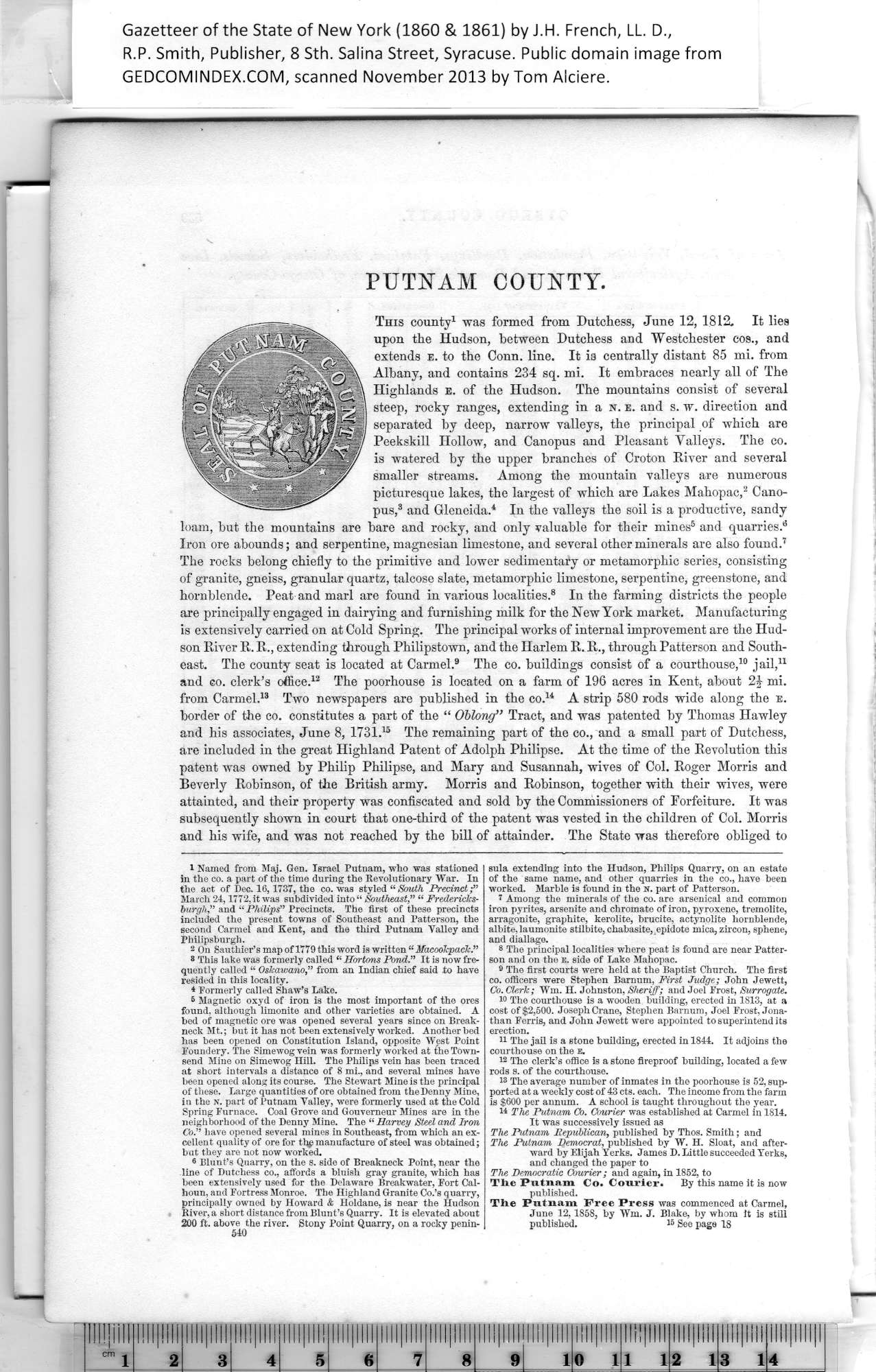|
PUTNAM COUNTY.
This county1 was formed from Dutchess, June 12, 1812, It lies
upon the Hudson, between Dutchess and Westchester cos., and
extends e. to the Conn. line. It is centrally distant 85 mi. from
Albany, and contains 234 sq. mi. It embraces nearly all of The
Highlands e. of the Hudson. The mountains consist of several
steep, rocky ranges, extending in a n. e. and s. w. direction and
separated by deep, narrow valleys, the principal of which are
Peekskill Hollow, and Canopus and Pleasant Yalleys. The co.
is watered by the upper branches of Croton River and several
smaller streams. Among the mountain valleys are numerous
picturesque lakes, the largest of which are Lakes Mahopac,2 Cano¬
pus,3 and Clencida.4 In the valleys the soil is a productive, sandy
loam, but the mountains are bare and rocky, and only valuable for their mines5 and quarries.4
Iron ore abounds; and serpentine, magnesian limestone, and several other minerals are also found.7
The rocks belong chiefly to the primitive and lower sedimentary or metamorphic series, consisting
of granite, gneiss, granular quartz, talcose slate, metamorphic limestone, serpentine, greenstone, and
hornblende. Peat- and marl are found in various localities.8 In the farming districts the people
are principally engaged in dairying and furnishing milk for the NewYork market. Manufacturing
is extensively carried on at Cold Spring. The principal works of internal improvement are the Hud¬
son River R. R., extending through Philipstown, and the Harlem R. R., through Patterson and South¬
east. The county seat is located at Carmel.5 The co. buildings consist of a courthouse,10 jail,11
and co. clerk’s office.12 The poorhouse is located on a farm of 196 acres in Kent, about 24 mi.
from Carmel.13 Two newspapers are published in the co.6 A strip 580 rods wide along the e.
border of the co. constitutes a part of the “ Oblong” Tract, and was patented by Thomas Hawley
and his associates, June 8, 1731.15 The remaining part of the co., and a small part of Dutchess,
are included in the great Highland Patent of Adolph Philipse. At the time of the Revolution this
patent was owned by Philip Philipse, and Mary and Susannah, wives of Col. Roger Morris and
Beverly Robinson, of the British army. Morris and Robinson, together with their wives, were
attainted, and their property was confiscated and sold by the Commissioners of Forfeiture. It was
subsequently shown in court that one-third of the patent was vested in the children of Col. Morris
and his wife, and was not reached by the bill of attainder. The State was therefore obliged to
|
sula extending into the Hudson, Philips Quarry, on an estate
of the same name, and other quarries in the co., have been
worked. Marble is found in the n, part of Patterson.
I Among the minerals of the co. are arsenical and common
iron pyrites, arsenite and chromate of iron, pyroxene, tremolite,
arragonite, graphite, kerolite, brucite, actynolite hornblende,
albite, laumonite stilbite, chabasite, .epidote mica, zircon, sphene,
and diallage.
8 The principal localities where peat is found are near Patter¬
son and on the e. side of Lake Mahopac.
9 The first courts were held at the Baptist Church. The first
co. officers were Stephen Barnum, First Judge; John Jewett,
Co. Clerk; Wm. H. Johnston, Sheriff; and Joel Frost, Surrogate.
10 The courthouse is a wooden building, erected in 1813, at a
cost of $2,500. Joseph Crane, Stephen Barnum, Joel Frost, Jona¬
than Ferris, and John Jewett were appointed to superintend its
erection.
II The jail is a stone building, erected in 1844. It adjoins the
courthouse on the e.
12 The clerk’s office is a stone fireproof building, located a few
rods s. of the courthouse.
18 The average number of inmates in the poorhouse is 52, sup¬
ported at a weekly cost of 43 cts. each. The income from the farm
is $600 per annum. A school is taught throughout the year.
14 The Putnam Co. Courier was established at Carmel in 1814.
It was successively issued as
The Putnam Republican, published by Thos. Smith; and
The Putnam Democrat, published by W. H. Sloat, and after¬
ward by Elijah Yerks. James D. Little succeeded Yerks,
and changed the paper to
The Democratic Courier; and again, in 1852, to
The Putnam Co. Courier. By this name it is now
published.
The Putnam Free Press was commenced at Carmel,
June 12, 1858, by Wm. J. Blake, by whom it is still
published. See page 18 |
1
Named from Maj. Gen. Israel Putnam, who was stationed
in the co. a part of the time during the Revolutionary War. In
the act of Dec. 16,1737, the co. was styled “South Precinct;”
March 24,1772, it was subdivided into “ Southeast,” “ Fredericks-
hurgh,” and “Philipp Precincts. The first of these precincts
included the present towns of Southeast and Patterson, the
second Carmel and Kent, and the third Putnam Yalley and
Philipsburgh.
2
On Sauthier’s map of1779 this word is written “ Macookpack.”
3
8 This lake was formerly called “ Hortons Pond.” It is now fre¬
quently called “ Oskawano,” from an Indian chief said to have
4
Magnetic oxyd of iron is the most important of the ores
found, although limonite and other varieties are obtained. A
bed of magnetic ore was opened several years since on Break¬
neck Mt.; but it has not been extensively worked. Another bed
has been opened on Constitution Island, opposite West Point
Foundery. The Simewogvein was formerly worked at the Town¬
5
of these. Large quantities of ore obtained from the Denny Mine,
in the n. part of Putnam Valley, were formerly used at the Cold
6
6 Blunt’s Quarry, on the s. side of Breakneck Point, near the
line of Dutchess co., affords a bluish gray granite, which has
|
